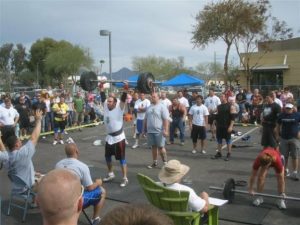Are All Functional Training Exercises The Same?
2019-04-22
It is understandable because I use to do it. I would get bored with an exercise and then just switch the piece of equipment I was using. As long as I was still performing or teaching the same exercise it didn’t matter what piece of equipment was being lifted, right? After all, I had heard “weight is weight” for years. Interestingly enough, the more I began to understand functional training, the more I had realized how much of a mistake I was making!

Not unfamiliar with lifting a variety of heavy things over my career.
Instead of just randomly throwing out tools to my training and those of my clients, I started to think about what was that functional training tool teaching me about the movement I was performing. Suddenly, I didn’t have a bigger toolbox, I had a better toolbox. My tools became an important means in which I solved the needs of clients and the goals we were trying to achieve.
Such a realization made my slap myself upside my head. Could you imagine going to a mechanic and telling them their tools didn’t matter? A chef is particular about the type of knives they use and tools they use in the kitchen. Ever use a saw like a hammer? Doesn’t allow you to accomplish much does it?

Something else very interesting happened, I started to get rid of a bunch of equipment that I realized didn’t bring something special or unique to the training. More and more I focused on functional training tools that had immense versatility not only in the exercises we could perform, but the means in which they could teach people how to move better.
Focusing on functional training tools in this manner actually made me a much better coach. Why? Because I became much more aware of the small details that many people that used this or that functional training tool would normally miss. I could create results that others could not because I was really emphasizing the “little things” that made a profound difference.
My cuing, progressions, and programs all improved. It was also pretty freeing to realize I didn’t have to use every tool, I had to use the RIGHT tool! Of course I realize we live in a cynical world where you may me thinking that I am just trying to get you to use Ultimate Sandbags and you would be partly correct!

It became less about how many tools I had but how powerful when I focused on how to optimize the tool they became!
When people approach me about using our DVRT program and Ultimate Sandbags they are astonished how many details go into every exercise. Don’t get me wrong, they aren’t complicated, but without those details the effectiveness drops and they do become kinda bags of sand. However, I am not trying to get you to use Ultimate Sandbags exclusively. Heck, our L.I.F.T. (loaded integrated functional training) Certification has many functional training tools in the program. Rather, I want people to see what functional training tool can yield the best result depending upon what we are trying to achieve.
A great example is our Around the Worlds. This DVRT drill is a favorite of mine because it accomplishes so many goals at once. We teach reflexive core training, we have mobility in the upper body while teaching stability in the trunk and lower body, there are elements of lifts/chops along with a plank. In other words, we achieve a lot of functional training goals with this lift. Especially when you realize that we can make this a strong anti-rotational drill or rotational. Both are highly effective but we look for slightly different things in each.
https://www.instagram.com/p/BwC-fYZBk8W/
Upon first seeing our anti-rotational versions, some people think of a kettlebell halo or a lever bell (mace) 360. Yes, all three are anti-rotational drills, but they aren’t the same! The kettlebell halo has our hands quite close making it more challenging to open up our upper body to greater levels. Our hands are the closest on the lever bell and not only does this expose us to similar issues, but it changes the range of motion of the exercise.
If you look how a kettlebell halo is performed, the range of motion is quite small. This reduces the core activation and the effectiveness of the lift/chop pattern. Of course someone is going to ask, “is this bad?” Well, it may not cause injury, but the better question is, “is it optimal?”
Could you imagine going to your doctor and having them tell you the medication, surgery, or treatment for you was just “good enough”. How excited would you be if home contractor said that they could do better, but they were okay with “good enough”? My point is that our goal as coaches is should aim for the best result possible, that is where selecting the right tool comes into play.
The lever bell has a similar path to the kettlebell and rightfully so! The long leverage of the weight makes our body smart to keep the range of motion as small as possible. Yet, again, we have to ask if we are making the exercise as GOOD as it can be in getting all the functional training attributes we discussed.
The reason that DVRT Master, Cory Cripe, created this comparison was to show the profound difference in range of motion doing the same exercise with different tools. This becomes most evident in the initiation and lower phases where we get the BIGGEST impact to the core through the diagonal patterns of lifts/chops.
Lifts/chops are diagonal patterns that train the core in the way it is designed to function.
I’m pretty prepared to this will make some people upset, or some may remain skeptical. It really shouldn’t though. I am not asking you to stop using your functional training tools like kettlebells and lever bells, what I am asking you is that can you explain WHY you are using that tool and is it create the best training effect possible.
https://www.instagram.com/p/BrbaDrgB1Gb/
We slowly build more efficiency of these lifts and chops by using rotational patterning to create more reflexive and higher level functional training.
Let’s have some honesty here too. When I present and people actually experience this themselves I get baffled my one response…..”I don’t have an Ultimate Sandbag, so what do I do?” Listen, my WHOLE mission for the past 15 years is to create cost efficient, high yielding training to fitness professionals and those that want to positively impact their lives. Yet, that question is troublesome.
If you wanted to perform lateral band walks but didn’t have a band, what would you do? If you wanted to perform kettlebell swings but didn’t have a kettlebell, what would you do (sorry dumbbell swings aren’t fun!). You hopefully get my point. I’m not trying to sell you on Ultimate Sandbags, I am trying to help you to understand that great craftsmen/women don’t randomly use tools, they use the RIGHT tool. I hope after years upon years of almost daily blogs that we have demonstrated we are here to be a solution to your training. When you see the bigger picture, you are rewarded with superior results!
DVRT Master, Larisa Lotz, shows that once we understand why we can build better and better movements!
https://www.instagram.com/p/BwarDyxn4I1/
© 2025 Ultimate Sandbag Training. Site by Jennifer Web Design.






